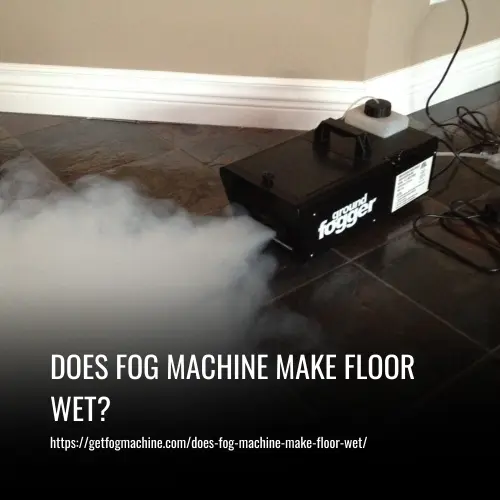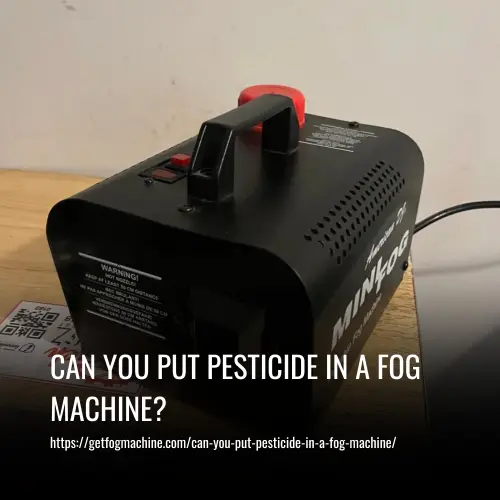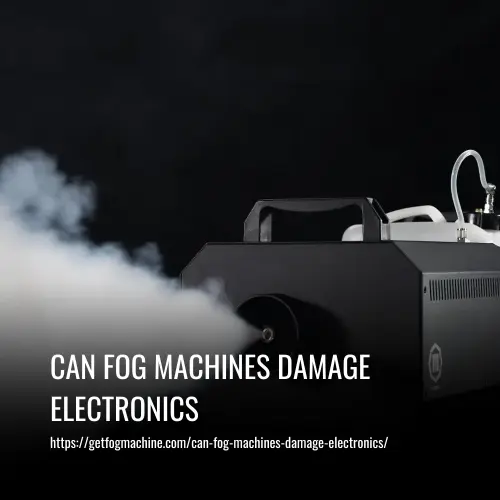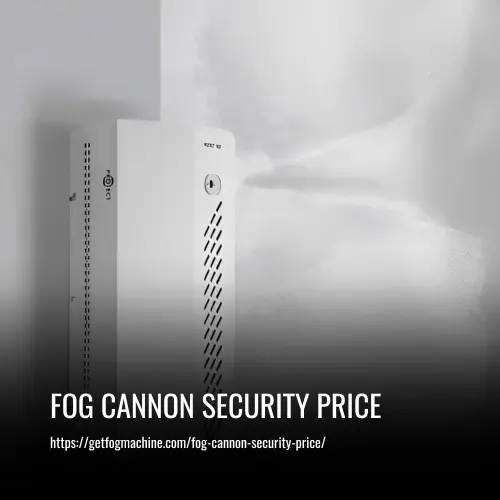Does Fog Machine Make Floor Wet?
This post contains affiliate links. As an Amazon Associate, we earn from qualifying purchases.
Yes, fog machines can make the floor wet. The smoke particles from the fog machine can settle on surfaces and leave a residue, which can make the floor wet. The amount of residue and wetness will depend on factors such as the density of the smoke, the duration of the effect, the type of fogger or hazer, and the type of fluid used.

Factors that Affect Floor Wetness from a Fog Machine
Fog machines are popular devices used to create special effects and atmospheric ambiance in various settings, such as stage performances, clubs, events, and film productions. These machines produce a dense fog or smoke-like vapor that can add excitement and drama to any environment.
However, one common concern among users is whether these fog machines can make the floor wet. Several factors contribute to the wetness of the floor when using a fog machine, including the type of machine and fluid used, the output nozzle design, the duration of fog emission, and the prevailing air temperature and movement.
Understanding these factors can help users minimize floor wetness and ensure a safe and enjoyable experience.
1. Type of Fog Machine
Different types of fog machines produce varying amounts of moisture. Dry ice machines and water-based fog machines typically have less liquid byproduct and are less likely to make the floor wet compared to oil-based or glycerin-based machines.
2. Fluid Usage
The amount of fog fluid used in the machine directly affects the wetness of the floor. Using less fluid or controlling the output can help minimize the moisture produced.
3. Heat-Up Time
Fog machines require time to heat up before producing fog. Allowing the machine to reach the optimal temperature can help reduce the amount of condensation that collects on the floor.
4. Air Movement
Air circulation in the area can affect the dispersion and movement of the fog. If there is strong air movement or drafts, the fog may disperse quickly and be less likely to settle on the floor.
5. Temperature and Humidity
The air temperature and humidity level can also impact the moisture content of the fog. Warmer air can hold more moisture, potentially leading to a wetter floor.
6. Particle Size
The size of the particles produced by the fog machine can influence the wetness of the floor. Smaller particles are more likely to condense and settle on surfaces, including the floor, making it wetter.
7. Output Nozzle
The type and design of the output nozzle can impact the dispersion of the fog. A wide-angle nozzle can create a wider spread and potentially result in less condensation on the floor.
8. Fluid Type
The type of fog fluid used can affect floor wetness. Some fluids produce a drier fog, while others may create a wetter fog with more visible droplets.
9. Heat Exchanger
The efficiency of the heat exchanger in the fog machine can impact the temperature of the fog. A well-designed heat exchanger can produce fog at a lower temperature, reducing the chances of floor wetness.
10. Duration of Fogging
The longer the fogging period, the more likely the floor is to become wet. Continuous fogging for an extended period may allow more time for the fog particles to settle and accumulate.
Tips for Minimizing Floor Wetness from Fog Machines
Fog machines are a popular choice for creating atmospheric effects in various settings, from stage performances to parties and events. However, one concern that arises with fog machines is the potential for wet or slippery floors.
Fortunately, there are several practical tips that can be followed to minimize floor wetness and ensure a safe environment.
1. Choose the Right Type of Fog Machine
Opt for a water-based or dry ice fog machine, as they produce less liquid byproduct compared to oil-based or glycerin-based machines. This will help minimize the wetness on the floor.
2. Control Fluid Usage
Use the fog machine’s controls to adjust the amount of fog fluid being released. Using less fluid or controlling the output can help decrease the moisture produced.
3. Allow Sufficient Heat-Up Time
Give your fog machine enough time to heat up before using it. This allows for better vaporization and reduces the chance of excessive condensation on the floor.
4. Consider Air Movement
Take into account the air circulation in the area where the fog machine is being used. If there are strong drafts or air movement, it can disperse the fog quickly, making it less likely to settle on the floor.
5. Monitor Temperature and Humidity
Be aware of the air temperature and humidity level. Warmer air has the capacity to hold more moisture, potentially leading to a wetter floor. Adjusting the environment or using dehumidifiers can help to minimize wetness.
6. Adjust the Output Nozzle
Position the output nozzle of the fog machine away from the floor. This helps to disperse the fog upwards, creating a more atmospheric effect without condensation settling on the floor.
7. Use the Right Fluid
Opt for a high-quality fog fluid that is specifically designed to produce fine particles. These fluids are less likely to create excessive moisture.
8. Consider Particle Size
Look for fog fluids that produce smaller particle sizes. These fine particles disperse more evenly in the air, reducing the chance of excess moisture settling on the floor.
9. Control Fog Output
Adjust the fog machine’s output settings to ensure a moderate level of fog. High output levels can create more moisture, leading to a wetter floor.
10. Position the Fog Machine Correctly
Place the fog machine in an area where its fog output is less likely to flow directly onto the floor. Position it higher or angle it away from the floor to minimize wetness.
11. Avoid Prolonged Fogging
Limit the duration of fog machine operation, particularly in small spaces. Shorter bursts of fog can help prevent excessive moisture buildup on the floor.
12. Regularly Test and Maintain the Machine
Keep your fog machine in good condition by following manufacturer recommendations for maintenance and cleaning. Regular testing ensures optimal performance and helps prevent excessive floor wetness.
By following these tips, you can enjoy the atmospheric effects of a fog machine while minimizing floor wetness.
FAQs
No, a fog machine does not directly make the floor wet. The fog produced by these machines is a vapor that quickly dissipates into the air. However, if the fog lingers in a closed space or if the floor is already wet, it may create a damp surface.
Choosing the right fog fluid is crucial. Look for fluids specifically designed for your fog machine, as they are formulated to create a clean fog without leaving residue. Avoid using low-quality or incompatible fluids, as they can leave behind a filmy residue on the floor.
Fog machines are generally safe when used properly. However, some fog fluids may contain chemicals that could be harmful if inhaled or come into contact with the skin. Read the safety warnings and instructions on the fog fluid packaging before use, and ensure proper ventilation in the area where the fog is being produced.
Using a fog machine outdoors can still create a visually stunning effect without wetting the ground. To prevent moisture on the ground, consider elevating the fog machine or placing it on a non-porous surface like a table or platform. Positioning the machine to disperse the fog higher in the air can also help maintain dry ground.
Conclusion
Fog machines do have the potential to make the floor wet, but it ultimately depends on various factors. The type of fog machine and fluid used, as well as the output nozzle and heat-up time, can all impact the amount of moisture generated.
It is important to consider the necessary precautions when using fog machines indoors or in enclosed spaces. For safety purposes, it is advisable to use fog fluids specifically designed for indoor use to minimize any potential residue film or health hazards.
Additionally, proper ventilation and air movement can help disperse the fog and reduce the chances of moisture accumulation on the floor. This is particularly important in industrial applications or during extended periods of fog usage.






